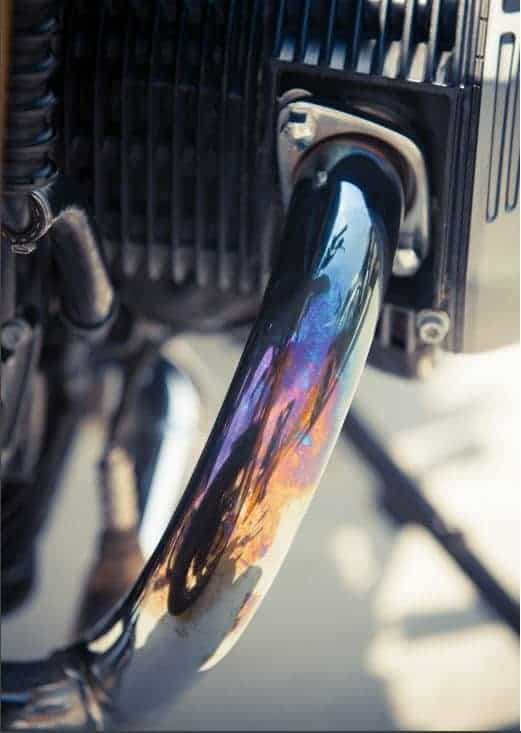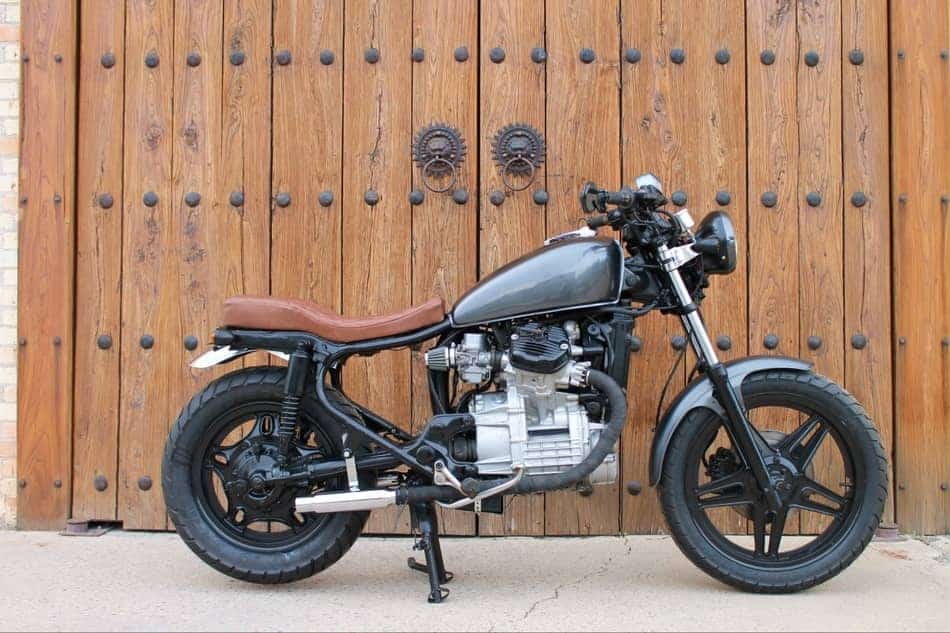
Most motorcyclists are proud to show off their motorcycle every time they go for a ride. And it’s no wonder because motorcycles are fun vehicles that can look pretty amazing if you take good care of them.
There are a few cosmetic issues that can happen on motorcycles and they can often be annoying. One of those issues may include the exhaust pipes turning blue for no clear reason at all. Not only is this annoying, it’s also embarrassing.
Why do motorcycle exhaust pipes turn blue? Motorcycle exhaust pipes turn blue as a result of extreme heat passing through them. This is usually caused by the motorcycle running lean, meaning there is too much air and too little gas being mixed together which causes a higher temperature to pass through the exhaust pipes.
I’ve run into my fair share of blue motorcycle pipes during my restoration days. As inconvenient as they are, it’s possible to get rid of it as well as take preventative measures to keep it from happening in the first place. This is what I’ve learned about the process.
Why Your Exhaust Pipes Are Turning Blue
The exhaust system on a motorcycle not only serves a vital function to the bike, but it can also be a statement according to your cosmetic taste. If someone is going to customize their motorcycle, the exhaust system is usually one of the most common things to be customized.
Because they’re so important to the cosmetic makeup of a motorcycle, owners usually pay special attention to how they look and start to worry and become annoyed when they start to turn a color that’s unintentional. Some people like the discoloration, but some don’t.
It’s actually pretty common when the exhaust pipes on a motorcycle turn blue, so don’t feel bad if you’ve become a victim of this phenomenon. Motorcycle exhaust pipes turn blue as a result of extreme heat passing through them. Obviously there’s already a good amount of heat passing through them, but if there’s an excessive amount or a hotter amount passing through, the result often ends with blue pipes.
Motorcyclists who rev their engines frequently may find that their pipes will eventually turn blue. Revving the engine makes it work harder which means excessive heat is passing through the pipes. Though revving your engine isn’t necessarily bad for it, it can result in something like this. For more information about whether or not it’s bad to rev your motorcycle engine, see my article here.
Another likely and more common culprit to the exhaust pipes turning blue is due to an engine that is running lean. When an engine runs lean, the carburetor (or sometimes even a fuel injector if you have one) will malfunction and either give too much air or not enough fuel to the engine.
When this happens, the combustion that happens in the combustion chamber of the engine gets much hotter which means the air passing through the exhaust pipes is at a higher temperature than normal. Some motorcycles exhaust pipes may be more susceptible to discoloration depending on the type of metal they’re made out of.
The heat turns the metal colors because of a process called oxidation. When the metal is heated to a high enough temperature, the metal can interact with the gas molecules and light waves around it. The ending color results in how much interaction the metal had with these elements. The extreme temperatures that can pass through motorcycle exhaust pipes that a motorcycle engine isn’t normally capable of producing usually results in a blue color.
Generally you’ll see that the base of the header pipes will have the most color on them since that’s where it’s takes most of the heat. The color will likely taper off the further down the pipe you get. If most of the pipe is blue, that likely means you’ve had an engine running lean for a while that hasn’t been addressed.
How To Fix Blue Exhaust Pipes
As I had mentioned before, some people actually don’t mind the discoloration of their motorcycle exhaust pipes. Some choose to simply keep the blue color that can be found on them. But if you’re one who doesn’t like it, there are several ways you can get rid of that blue color.
The first option you have is to simply replace the headers altogether. This is the most expensive option but is a task that can be completed by you in the comfort of your own garage. I’ve changed out dozens of exhaust pipes myself on motorcycles and found that it can be easily done yourself as long as you get the right ones.
There are tons of products out there that you will be able to easily use as a polish for your exhaust pipes. The discoloration of the pipes is essentially “caked” into the pipe, so it’s important to get a metal polished specifically made for “bluing” exhaust pipes.
Blue Job (link to Amazon.com) is an excellent choice among many and can help get the blue out of your motorcycle exhaust. You simply put the product on the pipes and work it in to polish it. It should eventually take out the blue that was initially formed.
If you’re open to having a new look on your motorcycle, another option you have is either painting your headers or using exhaust wrap. It may seem like a cover up, but I’ve done this on several of my motorcycle restorations and they turned out awesome.

If you’re going to paint the exhaust pipes, make sure to get a high quality paint that is high heat-tolerant so you don’t run into issues when you start the motorcycle. Exhaust wrap can easily be applied with a few hours in your garage. See my article here to know more about the pros and cons of using motorcycle exhaust wrap.
Prevention
Though having blue motorcycle pipes isn’t necessarily detrimental to the function of a motorcycle, it could be a sign of an underlying issue. Here are some things to look for if you suspect there is something else going on with your bike.
If the blue has slowly appeared on your pipes, that’s likely a sign that it’s normal wear and tear on your motorcycle. This is especially true if the blue is very light and hardly noticeable. If this is the case, you’ll just need to polish your pipes routinely, probably once a month.
If the blue color has appeared quickly or suddenly, think about your riding habits. Are you often revving your engine? Or do you have a high idle? These are two big reasons that extreme heat could be passing through the pipes. Unless you’re willing to constantly polish your pipes, decrease the amount of times you rev your motorcycle.
If your riding habits aren’t the issue, your likely culprit is that your motorcycle is running lean. If that’s the case, this is something you’ll want to promptly fix because it can cause bigger issues down the road. Other symptoms of a motorcycle running lean is backfiring in the exhaust pipes and occasional lurching forward while riding.
A motorcycle running lean is usually caused by a carburetor malfunctioning because it isn’t giving the right fuel to air ratio (it usually gives too much air). This is simply a matter of getting your carburetor tuned. Also note that this can also be caused by using aftermarket air filtering systems.
I have created an entire video series about restoring/rebuilding motorcycles from start to finish. Within this series includes in depth videos about carb rebuilds and tutorials on how to install exhaust wrap properly. Also included are videos about hard-to-tackle tasks such as body work and electrical. Click here for more information if you’re interested in restoring/building your dream motorcycle!
What About The Other Colors?
It’s possible for metal to turn all sorts of different colors depending on what temperature you can get it at. Aside from the exhaust pipes on a motorcycle turning blue, another common color you may see is yellow or gold.
With a lot of headers that are discoloring, you’ll notice a mix of these two colors. The yellowing of exhaust pipes happens through the same process as the appearance of blue. Essentially, yellowing is the warning sign that blue will eventually appear if it is not polished in time.
Yellow exhaust pipes are usually a little easier to polish than blue pipes since blue indicates a more mature oxidation process. If you start noticing the yellowing discoloration of your exhaust pipes, it’s a good idea to start tackling the problem now rather than when it becomes worse and turns blue.
Related Questions
What is the best exhaust wrap to use on motorcycle exhaust? Though there are several options of exhaust wrap to use on a motorcycle, fiberglass wrap has yielded the best results. It is less expensive and shows to have the same quality as other wraps. Click here to see the exhaust wrap I recommend in my list of suggested motorcycle upgrades.
How much does it cost to get a motorcycle carburetor tuned? If you plan to take your motorcycle in to a shop to get the carburetor tuned, the average price is between $75-$100 per carb. So if you have a four cylinder engine, the cost will range between $300 – $400.

